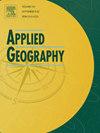Exploring an adaptive management model for “status-optimization-regulation” of mining city in transition: A case study of Huangshi, China
IF 4
2区 地球科学
Q1 GEOGRAPHY
引用次数: 0
Abstract
Mining cities face the challenges of ecological transformation and sustainable development after mineral depletion. Thus, ecological space optimization and adaptive management are pivotal after ecological restoration project, but easily neglected. Taking Huangshi in Hubei Province as an example, a top-down adaptive management model for regional mining ecological space integrating status-optimization-regulation (SOR) was established based on land system resilience (LSR) evaluation, circuit theory, complex network model and community discovery algorithm. The results showed that i) As the LSR increased, the land use structure shifted from non-ecological zones to forest and cropland, indicating that balancing agriculture and forest protection was crucial for increasing LSR in Huangshi. i) The ecological networks (ENs) of Huangshi had an irregular fishnet pattern, with densely intricate corridors in the south and broader, sparser ones in the north, and numerous ecological barriers near the mining area. Furthermore, the distribution of ecological sources and corridors displayed complementarity and hierarchy. iii) The optimized ENs exhibited higher connectivity and efficiency under disturbance, reducing corridor redundancy and migration costs. iv) The ENs clusters were classified into five types based on ecological connectivity: ecological buffer zone, priority restoration zone, moderate restoration zone, natural restoration zone, and moderate development zone, and tailored ecological regulatory strategies were proposed. The findings provide practice-oriented guidance for the sustainable development of mining cities, and offer a direct approach to support conscious, clear, and coherent adaptive management of ecological restoration in rapidly changing environments.
探索转型期矿业城市 "现状-优化-调控 "的适应性管理模式:中国黄石案例研究
矿业城市面临着矿产枯竭后生态转型和可持续发展的挑战。因此,生态空间优化和适应性管理在生态修复工程后至关重要,但却容易被忽视。以湖北省黄石市为例,基于土地系统恢复力(LSR)评价、回路理论、复杂网络模型和群落发现算法,建立了集现状-优化-调控(SOR)为一体的自上而下的区域矿山生态空间适应性管理模式。结果表明:i)随着土地系统恢复力的提高,土地利用结构由非生态区向森林和耕地转变,这表明平衡农业和森林保护对提高黄石的土地系统恢复力至关重要;ii)黄石的生态网络(ENs)呈不规则鱼网状,南部走廊密集错综,北部走廊宽阔稀疏,矿区附近生态屏障众多。iii)优化后的 ENs 在干扰条件下表现出更高的连通性和效率,减少了廊道冗余和迁移成本;iv)根据生态连通性将 ENs 群划分为五种类型:生态缓冲区、优先恢复区、适度恢复区、自然恢复区和适度发展区,并提出了有针对性的生态调控策略。研究结果为矿业城市的可持续发展提供了以实践为导向的指导,并为在快速变化的环境中有意识地、清晰地、协调一致地进行生态恢复适应性管理提供了直接方法。
本文章由计算机程序翻译,如有差异,请以英文原文为准。
求助全文
约1分钟内获得全文
求助全文
来源期刊

Applied Geography
GEOGRAPHY-
CiteScore
8.00
自引率
2.00%
发文量
134
期刊介绍:
Applied Geography is a journal devoted to the publication of research which utilizes geographic approaches (human, physical, nature-society and GIScience) to resolve human problems that have a spatial dimension. These problems may be related to the assessment, management and allocation of the world physical and/or human resources. The underlying rationale of the journal is that only through a clear understanding of the relevant societal, physical, and coupled natural-humans systems can we resolve such problems. Papers are invited on any theme involving the application of geographical theory and methodology in the resolution of human problems.
 求助内容:
求助内容: 应助结果提醒方式:
应助结果提醒方式:


